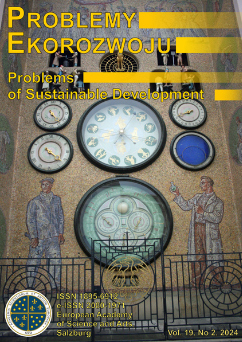Dystans trudny do pokonania? Analiza pozycji Norwegii i Polski na drodze do zrównoważonego rozwoju
Artur Zimny
State University of Applied Sciences in Konin, Faculty of Social Sciences and Humanities, Department of Managerial Studies and Logistics, ul. Przyjaźni 1, 62-510 Konin (Polska)
Karina Zawieja-Żurowska
State University of Applied Sciences in Konin, Faculty of Social Sciences and Humanities, Department of Political Studies and Internal Security, ul. Przyjaźni 1, 62-510 Konin (Polska)
Abstrakt
Zrównoważony rozwój jest niewątpliwie kluczowym wyzwaniem współczesnego świata. Na drodze do tego rozwoju Polska pozostaje w tyle za wieloma krajami, a w szczególności za Norwegią, która wydaje się być niekwestionowanym liderem w Europie. Dystans dzielący Norwegię i Polskę występuje we wszystkich dziesięciu wymiarach (obszarach tematycznych) ujętych w Strategii Zrównoważonego Rozwoju UE (rozwój społeczno-gospodarczy, zrównoważona konsumpcja i produkcja, włączenie społeczne, zmiany demograficzne, zdrowie publiczne, zmiana klimatu i energia, zrównoważony transport, zasoby naturalne, globalne partnerstwo, dobre rządzenie). Niestety jest bardzo mało prawdopodobne, aby dystans ten uległ w najbliższych latach znaczącemu zmniejszeniu. Polsce nie pozostaje nic innego jak tylko pogodzić się z tym faktem i jednocześnie uczyć się od lidera i czerpać z jego doświadczeń, a także korzystać ze wsparcia udzielanego z funduszy norweskich i funduszy EOG – w celu zmniejszania dystansu w zakresie zrównoważonego rozwoju oraz wzmacniania dwustronnych stosunków pomiędzy Norwegią a Polską.
Słowa kluczowe:
zrównoważony rozwój, dystans rozwojowy, Polska, NorwegiaBibliografia
CBOS, 2013, Poczucie wpływu na sprawy publiczne, Komunikat z badań CBOS nr BS/121/2013, Warszawa, p. 1.
Google Scholar
CBOS, 2014, Opinie o działalności parlamentu, prezydenta i Państwowej Komisji Wyborczej, Komunikat z badań CBOS nr 169/2014, Warszawa, p. 1.
Google Scholar
EUROPEAN COMMISSION, UE Budget in My Country, http://ec.europa.eu/budget/mycountry/PL (12.02.2015).
Google Scholar
EUROPEAN COMMISSION, 2005, The 2005 Review of the EU Sustainable Development Strategy: Initial Stocktaking and Future Orientation, COM(2005) 37 final, Brussels.
Google Scholar
EUROPEAN COMMISSION, 2007, Progress Report on the Sustainable Development Strategy 2007, COM(2007) 642 final, Brussels.
Google Scholar
EUROPEAN COMMISSION, 2009, Mainstreaming sustainable development into EU policies: 2009 Review of the European Union Strategy for Sustainable Development, COM(2009) 400 final, Brussels.
Google Scholar
EUROPEAN COMMISSION, 2010, Europe 2020. A European Strategy for smart, sustainable and inclusive growth, http://ec.europa.eu/eu2020/pdf/COMPLET%20EN%20BARROS0%20%20%20007%20-%20Europe% 202020%20-%20EN%20version.pdf (1.02.2015).
Google Scholar
EUROPEAN COUNCIL, 2001, A Sustainable Europe for a Better World: A European Union Strategy for Sustainable Development, COM(2001)264 final, Brussels.
Google Scholar
EUROPEAN COUNCIL, 2006, Renewed EU Sustainable Development Strategy, Brussels.
Google Scholar
EUROSTAT, Headline Indicators, http://ec.europa.eu/eurostat/web/sdi/indicators (6.02.2015).
Google Scholar
EUROSTAT, 2013, 2013 monitoring report of the EU sustainable development strategy, Luxembourg.
Google Scholar
EUROPEAN UNION, 2008, Consolidated Version of the Treaty on European Union, http://www.basiclaw.net/Appendices/eu_cons_treaty_en.pdf (1.03.2015).
Google Scholar
Fundusze norweskie i EOG na lata 2009-2014, http://www.eog.gov.pl (12.02.2015).
Google Scholar
GŁÓWNY URZĄD STATYSTYCZNY, Information Portal, http://stat.gov.pl (06.02.2015).
Google Scholar
GŁÓWNY URZĄD STATYSTYCZNY, URZĄD STATYSTYCZNY W KATOWICACH, 2011, Wskaźniki zrównoważonego rozwoju Polski, Katowice, p. 8.
Google Scholar
Konstytucja Rzeczypospolitej Polskiej z dnia 2 kwietnia 1997 r., 1997, Dz. U. z 1997 r. Nr 78 poz. 483 z późn. zm., art. 5.
Google Scholar
OECD, Statistics, http://stats.oecd.org/Index.aspx (06.02.2015).
Google Scholar
RYDZEWSKI P., 2015, Sustainable Development as Seen by the Residents of Eastern and Western Europe on the Basis of ISSP Environment Data, in: Problemy Ekorozwoju/ Problems of Sustainable Development, vol. 10, no 1, p. 49-53.
Google Scholar
Ustawa z dnia 27 kwietnia 2001 r. Prawo ochrony środowiska, 2001, Dz. U. z 2001 r. Nr 62 poz. 627 z późn. zm., art. 3 pkt 50.
Google Scholar
WCED, 1987, Our Common Future, Oxford University Press, New York.
Google Scholar
WORLD BANK, Indicators, http://data.worldbank.org/indicators (10.02.2015).
Google Scholar
Autorzy
Artur ZimnyState University of Applied Sciences in Konin, Faculty of Social Sciences and Humanities, Department of Managerial Studies and Logistics, ul. Przyjaźni 1, 62-510 Konin Polska
Autorzy
Karina Zawieja-ŻurowskaState University of Applied Sciences in Konin, Faculty of Social Sciences and Humanities, Department of Political Studies and Internal Security, ul. Przyjaźni 1, 62-510 Konin Polska
Statystyki
Abstract views: 27PDF downloads: 8
Licencja

Utwór dostępny jest na licencji Creative Commons Uznanie autorstwa – Na tych samych warunkach 4.0 Miedzynarodowe.




